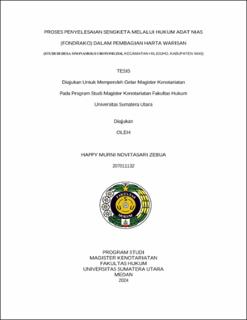Proses Penyelesaian Sengketa Melalui Hukum Adat Nias (FONDRAKO) dalam Pembagian Harta Warisan (Studi di Desa Ononamolo I Botomuzoi, Kecamatan Hiliduho, Kabupaten Nias)
The Process of Dispute Resolution Through the Nias Adat Law (Fondrako) in Resolving the Distribution of Inheritance (A Study at Ononamolo Village, Botomuzoi, Hiliduho Subdistrict, Nias Regency

Date
2024Author
Zebua, Happy Murni Novitasari
Advisor(s)
Sembiring, Rosnidar
Maria
Metadata
Show full item recordAbstract
An adat (cutomary) law is called as an unstatute law which is different from the statute law as a written one. It is a cultural product containing the substance of cultural values as a human creation, will, and sense. It means that an adat law is born from the human awareness of needs and willingness to live righteously and respectfully as the actualization of human civilzation. Nias is a region which followspatrileal system. A adat law today becomes the local wisdom which is followed and applied by the Nias community, and even its heritage is still conserved. One of the adat laws which is still followed by them is ‘fondrako’ that is considered as their system of life. ‘Fondrako’ itself is a law which organizes religious, ethic, aesthetic, and social problems.
This research uses descriptive analytic research method with juridical sociological (empirical) approach. The research location is at Ononamolo I village, Botomuzoi, Hiliduho Sub-district, Nias Regency. The samples are taken from the respondents and information through interviews and completed by conducting library research. The gathered data are analyzed qualitatively and done systeatically by using deductive and inductive methods.
The result of the research shows that the law in distributing inhertance follows the adat law in which a son has higher position that of a daughter since he is considered as the continuer of the clan, and the oldest son has the bigger portion that of the other sons. The distribution of inheritance is divide into 2 (two) methods: when the testator is still alive and when he is already dead. If there is a dispute, it will be resolved according to the adat law which is called ‘Fondrako’ or ‘Mondrako’ which is done through 3 (three) methods: ‘orahua sifatalifuso’ or family negotiation, ‘orahua zato’ or public/neighborhood negotiation attended by non-relatives as itnesses, adat leaders, and public figures, and ‘orahua mbanua’ attended by public figures and carried out in front of some adat leaders from the surrounding villages until the negotiation yields solution or decision which is
Collections
- Master Theses (Notary) [2280]
